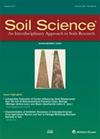Improving models to predict holocellulose and Klason lignin contents for peat soil organic matter with mid-infrared spectra
4区 农林科学
Q2 Agricultural and Biological Sciences
引用次数: 1
Abstract
Abstract. To understand global soil organic matter (SOM) chemistry and its dynamics, we need tools to efficiently quantify SOM properties, for example, prediction models using mid-infrared spectra. However, the advantages of such models rely on their validity and accuracy. Recently, Hodgkins et al. (2018) developed models to quantitatively predict peat holocellulose and Klason lignin contents, two indicators of SOM stability and major fractions of organic matter. The models may help to understand large-scale SOM gradients and have been used in various studies. A research gap to fill is that these models have not been validated in detail yet. What are their limitations and how can we improve them? This study provides a validation with the aim to identify concrete steps to improve these models. As a first step, we provide several improvements using the original training data. The major limitation we identified is that the original training data are not representative for a range of diverse peat samples. This causes both biased estimates and extrapolation uncertainty under the original models. In addition, the original models can in practice produce unrealistic predictions (negative values or values >100 mass-%). Our improved models partly reduce the observed bias, have a better predictive performance for the training data, and avoid such unrealistic predictions. Finally, we provide a proof of concept that holocellulose contents can also be predicted for mineral-rich samples (e.g., peat with mineral admixtures or potentially mineral soils). A key step to improve the models will be to collect training data that are representative for SOM formed under various conditions. This study opens directions to develop operational models to predict SOM holocellulose and Klason lignin contents from mid-infrared spectra.改进中红外光谱预测泥炭土有机质中纤维素和木质素含量的模型
摘要为了了解全球土壤有机质(SOM)化学及其动态,我们需要有效量化SOM性质的工具,例如使用中红外光谱的预测模型。然而,这些模型的优势在于它们的有效性和准确性。最近,Hodgkins等人(2018)开发了定量预测泥炭总纤维素和Klason木质素含量的模型,这是SOM稳定性和有机质主要组分的两个指标。这些模型可以帮助理解大尺度的SOM梯度,并已在各种研究中使用。需要填补的一个研究空白是,这些模型尚未得到详细的验证。它们的局限性是什么,我们如何改进它们?本研究提供了一个验证,旨在确定改进这些模型的具体步骤。作为第一步,我们使用原始训练数据提供了一些改进。我们发现的主要限制是原始训练数据不能代表各种泥炭样本的范围。这导致了原始模型下的估计偏差和外推不确定性。此外,原始模型在实际中可能产生不切实际的预测(负值或>100质量-%)。我们改进的模型在一定程度上减少了观测偏差,对训练数据有了更好的预测性能,避免了这种不切实际的预测。最后,我们提供了一个概念证明,即对于富含矿物质的样品(例如,含矿物外加剂的泥炭或潜在的矿物土壤),也可以预测综纤维素含量。改进模型的关键步骤是收集在各种条件下形成的SOM具有代表性的训练数据。本研究为利用中红外光谱预测SOM总纤维素和木质素含量的操作模型的建立开辟了方向。
本文章由计算机程序翻译,如有差异,请以英文原文为准。
求助全文
约1分钟内获得全文
求助全文
来源期刊

Soil Science
农林科学-土壤科学
CiteScore
2.70
自引率
0.00%
发文量
0
审稿时长
4.4 months
期刊介绍:
Cessation.Soil Science satisfies the professional needs of all scientists and laboratory personnel involved in soil and plant research by publishing primary research reports and critical reviews of basic and applied soil science, especially as it relates to soil and plant studies and general environmental soil science.
Each month, Soil Science presents authoritative research articles from an impressive array of discipline: soil chemistry and biochemistry, physics, fertility and nutrition, soil genesis and morphology, soil microbiology and mineralogy. Of immediate relevance to soil scientists-both industrial and academic-this unique publication also has long-range value for agronomists and environmental scientists.
 求助内容:
求助内容: 应助结果提醒方式:
应助结果提醒方式:


